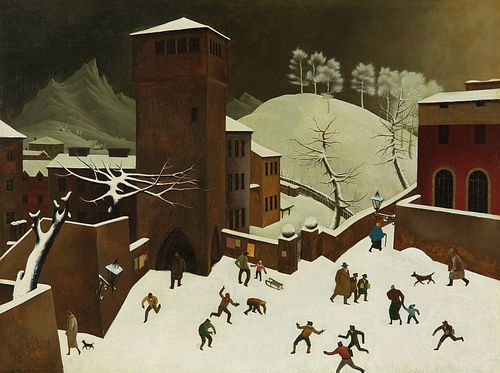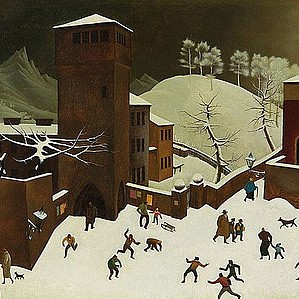FRANZ SEDLACEK (Wroclaw 1891 - 1945 missing) Winter Landscape with Tower
Lot 157
Estimate:
EUR€400,000 - EUR€800,000
$416,666.67 - $833,333.33
Absentee vs Live bid
Two ways to bid:
- Leave a max absentee bid and the platform will bid on your behalf up to your maximum bid during the live auction.
- Bid live during the auction and your bids will be submitted real-time to the auctioneer.
Bid Increments
| Price | Bid Increment |
|---|---|
| EUR€0 | EUR€10 |
| EUR€100 | EUR€50 |
| EUR€700 | EUR€100 |
| EUR€1,000 | EUR€200 |
| EUR€3,000 | EUR€300 |
| EUR€3,600 | EUR€400 |
| EUR€4,000 | EUR€500 |
| EUR€7,000 | EUR€1,000 |
| EUR€16,000 | EUR€2,000 |
| EUR€30,000 | EUR€3,000 |
| EUR€36,000 | EUR€4,000 |
| EUR€40,000 | EUR€5,000 |
About Auction
By Widder Auctions
May 19, 2022
Set Reminder
2022-05-19 11:00:00
2022-05-19 11:00:00
America/New_York
Bidsquare
Bidsquare : Masterpieces
https://www.bidsquare.com/auctions/widder-auctions/masterpieces-9287
Masterpieces of classical modernism by Austrian and international artists coming up for auction in Vienna on May 19th Widder Auctions office@widderauktionen.com
Masterpieces of classical modernism by Austrian and international artists coming up for auction in Vienna on May 19th Widder Auctions office@widderauktionen.com
- Lot Description
FRANZ SEDLACEK
(Wroclaw 1891 - 1945 missing)
Winter Landscape with Tower
oil/wood, 47,1 x 63 cm
monogrammed fs and dated 1933
verso inscribed Franz Sedlacek Wien, 1933 "Winterlandschaft mit Turm", as well as label of the Vereinigung Bildender Künstler Vienna Secession
exhibited at the Vienna Secession in 1933
depicted in the 1933 Secession catalog I, no. 57; in The Painter and Graphic Artist Dr. Franz Sedlacek, dissertation Innsbruck 1987, p. 257, no. 78; in the exhibition catalog Neue Sachlichkeit, Kunstforum Vienna 1995, p. 65, fig. 69; in the catalog raisonné of Franz Sedlacek, Vienna 2011, p. 96 and p. 189, with the number WV 88
Provenance: private collection Hungary, Fine Arts Widder Vienna, European private collection
ESTIMATE € 400.000 - 800.000
Austrian painter of the 20th century, especially of the interwar period. Main representative of the New Objectivity. Born in Breslau and grew up in Linz in Upper Austria. Studied architecture and chemistry in Vienna from 1910. Together with Anton Lutz, Franz and Klemens Brosch and Heinz Bitzan, he founded in 1913 the Linz artists' association MAERZ. Worked from 1921 at the Technical Museum in Vienna in the Department of Chemical Industry. 1927 Member of the Vienna Secession. From 1928 friendship with Herbert Reyl-Hanisch, also stylistic proximity to his works.. 1939 War deployment in Stalingrad, Norway and Poland, considered missing in action since 1945. Inspired by the art of Romanticism and Flemish-Dutch painting by Joachim Patinier, Joss de Momper, Pieter Bruegel the Elder and Michael Wuttky. Stylistically located between Magic Realism and New Objectivity. Created mainly romantic landscapes, magical worlds, floral still lifes and winter pictures with skiers or snowball fights in old master painting style. In the dream worlds cavort bizarre and grotesque creatures combined with set pieces from technology and everyday life. Fantastic, partly gloomy mood reminds one of Alfred Kubin or the texts of Gustav Meyrink and Edgar Allen Poe.
Franz Sedlacek is indisputably one of the most extraordinary painters of the Austrian interwar art scene. Long forgotten, the studied chemist was celebrated as a new discovery among the fantastic realists in the late 1970s. Sedlacek initially focused on graphics before turning to oil painting. Here he made a noise in the world with new-objective pictures painted in the glaze technique of the old masters. A magical, surreal moment is always inherent in his precisely designed paintings. In addition to still lifes, landscapes with many figures play the most important role in his work. In the early 1930s, Franz Sedlacek created a series of four urban winter landscapes. They reveal Sedlacek's relation to German Romanticism and, in particular, his examination of the work of Caspar David Friedrich, whose light drama and silhouette effect noticeably influenced Sedlacek's work. Three of these cityscapes hang in important public collections. The fourth present picture, like its creator himself, has been considered lost since the war. The rediscovery of this major work of New Objectivity (Neue Sachlichkeit), which would do credit to any museum, can without exaggeration be rated as a sensation. Meticulously composed down to the last detail, the winter landscape from 1933 under a dark sky is an excellent example of Sedlacek's technical and artistic mastery. The mysterious is metaphorically combined with twilight, dusk and night. The art of painting moves in the infinite mixture of light and dark; between the poles of unambiguity and ambiguity. Intuitions, fears, assumptions and danger unsettle us. The second half of the 19th century was downright “addicted to twilight”, not only in the visual arts, but also in poetry and music. The "shady", sinister characters of romance and the Gothic Revival moved from godforsaken landscapes, deep forests, dilapidated castles and monasteries to the cities in the 20th century. Hans Holländer writes: "Gustav Meyrink's Golem haunts the old Prague ghetto, Kubin's utopian city fantasy consists of old, disreputable houses, and often the special, thoroughly dubious effect is the non-simultaneity of the simultaneous with the collision of the old with the new." Franz Sedlacek himself wrote a posthumously published fantastic story entitled Die Stadt, which states: “Our city was short 40,000 inhabitants, traversed by a winding River stream and lay at the foot of a mighty mountain range, that crashed towards her in terrible cliffs from the north. These walls were cut by numerous gorges, through wich the small and larger torrents came down as waterfalls came down, which then joined the river mostly through vaulted canals.” At first glance, the scenery of the painting shows with the perspective depth effect typical of Sedlacek happy people in a snowy urban landscape with sculpturally modeled buildings in front of a snowy hill and, farther in the background, a snow covered mountain range. The adults walk peacefully their path, the children clearly have fun. Does the tower foreshadow something gloomy, or does it rather stands for protection and defiance, while the actual menace lurks in the distant white mountains, in this cold, infinite universal landscape? It is this abysmal mysteriousness that captivates the viewer and makes us contemplate the human condition.
PLEASE NOTE:
The purchase price consists of the highest bid plus the buyer's premium, sales tax and, if applicable, the fee of artists resale rights. In the case of normal taxation (marked ° in the catalog), a premium of 24% is added to the highest bid. The mandatory sales tax of 13% is added to the sum of the highest bid and the buyer's premium. The buyer's premium amounts to 28% in case of differential taxation. The sales tax is included in the differential taxation. - Shipping Info
-
Shipping
We will send you the invoice shortly after the auction. As soon as we have recieved the amount, the art can be picked up at Johannesgasse 9-13, 1010 Vienna. Please note that the buyer is responsible for pick-up and shipping of the lot.
Should you wish to ship your items, please contact: Mailboxes Email: oper@mbe-co.at Tel: 01 5128855
Please note that storage fees may apply, should the pieces not be picked up within 14 days after invoicing for domestic and 28 days for international transportation.
Our team will be happy to assist you with any further information at office@widderauktionen.com or at 0043 676 555 66 10.
-
- Buyer's Premium



 EUR
EUR CAD
CAD AUD
AUD GBP
GBP MXN
MXN HKD
HKD CNY
CNY MYR
MYR SEK
SEK SGD
SGD CHF
CHF THB
THB
















